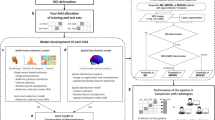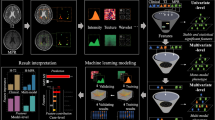Abstract
Objective
To develop and validate an individual radiomics nomogram for differential diagnosis between multiple sclerosis (MS) and neuromyelitis optica spectrum disorder (NMOSD).
Methods
We retrospectively collected 67 MS and 68 NMOSD with spinal cord lesions as a primary cohort and prospectively recruited 28 MS and 26 NMOSD patients as a validation cohort. Radiomic features were extracted from the spinal cord lesions. A prediction model for differentiating MS and NMOSD was built by combining the radiomic features with several clinical and routine MRI measurements. The performance of the model was assessed with respect to its calibration plot and clinical discrimination in the primary and validation cohorts.
Results
Nine radiomics features extracted from an initial set of 485, predominantly reflecting lesion heterogeneity, combined with lesion length, patient sex, and EDSS, were selected to build the model for differentiating MS and NMOSD. The areas under the ROC curves (AUC) for differentiating the two diseases were 0.8808 and 0.7115, for the primary and validation cohort, respectively. This model demonstrated good calibration (C-index was 0.906 and 0.802 in primary and validation cohort).
Conclusions
A validated nomogram that incorporates the radiomic signature of spinal cord lesions, as well as cord lesion length, sex, and EDSS score, can usefully differentiate MS and NMOSD.
Key Points
• Radiomic features of spinal cord lesions in MS and NMOSD were different.
• Radiomic signatures can capture pathological alterations and help differentiate MS and NMOSD.




Similar content being viewed by others
Abbreviations
- AUC:
-
Areas under the ROC curves
- EDSS:
-
Expanded disability status scale
- LASSO:
-
Least absolute shrinkage and selection operator
- LETM:
-
Longitudinal extensive transverse myelitis
- MS:
-
Multiple sclerosis
- NMOSD:
-
Neuromyelitis optica spectrum disorder
- ROC:
-
Receiver operating characteristic
- ROI:
-
Region of interest
- RRMS:
-
Relapsing-remitting MS
References
Noseworthy JH, Lucchinetti C, Rodriguez M, Weinshenker BG (2000) Multiple sclerosis. N Engl J Med 343:938–952
Wingerchuk DM, Lennon VA, Lucchinetti CF, Pittock SJ, Weinshenker BG (2007) The spectrum of neuromyelitis optica. Lancet Neurol 6:805–815
Palace J, Leite MI, Nairne A, Vincent A (2010) Interferon Beta treatment in neuromyelitis optica: increase in relapses and aquaporin 4 antibody titers. Arch Neurol 67:1016–1017
Shimizu J, Hatanaka Y, Hasegawa M et al (2010) IFNbeta-1b may severely exacerbate Japanese optic-spinal MS in neuromyelitis optica spectrum. Neurology 75:1423–1427
Thompson AJ, Banwell BL, Barkhof F et al (2017) Diagnosis of multiple sclerosis: 2017 revisions of the McDonald criteria. Lancet Neurol 17:162–173
Wingerchuk DM, Banwell B, Bennett JL et al (2015) International consensus diagnostic criteria for neuromyelitis optica spectrum disorders. Neurology 85:177–189
Min JH, Kim BJ, Lee KH (2012) Development of extensive brain lesions following fingolimod (FTY720) treatment in a patient with neuromyelitis optica spectrum disorder. Mult Scler 18:113–115
Jarius S, Ruprecht K, Wildemann B et al (2012) Contrasting disease patterns in seropositive and seronegative neuromyelitis optica: a multicentre study of 175 patients. J Neuroinflammation 9:14
Gass A, Rocca MA, Agosta F et al (2015) MRI monitoring of pathological changes in the spinal cord in patients with multiple sclerosis. Lancet Neurol 14:443–454
Lambin P, Rios-Velazquez E, Leijenaar R et al (2012) Radiomics: extracting more information from medical images using advanced feature analysis. Eur J Cancer 48:441–446
Gillies RJ, Kinahan PE, Hricak H (2016) Radiomics: images are more than pictures, they are data. Radiology 278:563–577
Iasonos A, Schrag D, Raj GV, Panageas KS (2008) How to build and interpret a nomogram for cancer prognosis. J Clin Oncol 26:1364–1370
Polman CH, Reingold SC, Banwell B et al (2011) Diagnostic criteria for multiple sclerosis: 2010 revisions to the McDonald criteria. Ann Neurol 69:292–302
Aerts HJ, Velazquez ER, Leijenaar RT et al (2014) Decoding tumour phenotype by noninvasive imaging using a quantitative radiomics approach. Nat Commun 5:4006
Tibshirani R (1996) Regression shrinkage and selection via the lasso. J R Stat Soc Series B Stat Methodol 58:267–288
Lukas C, Knol DL, Sombekke MH et al (2015) Cervical spinal cord volume loss is related to clinical disability progression in multiple sclerosis. J Neurol Neurosurg Psychiatry 86:410–418
Liu Y, Wang J, Daams M et al (2015) Differential patterns of spinal cord and brain atrophy in NMO and MS. Neurology 84:1465–1472
Fan M, Fu Y, Su L et al (2017) Comparison of brain and spinal cord magnetic resonance imaging features in neuromyelitis optica spectrum disorders patients with or without aquaporin-4 antibody. Mult Scler Relat Disord 13:58–66
Kumar V, Gu Y, Basu S et al (2012) Radiomics: the process and the challenges. Magn Reson Imaging 30:1234–1248
Zhang Y, Moore GR, Laule C et al (2013) Pathological correlates of magnetic resonance imaging texture heterogeneity in multiple sclerosis. Ann Neurol 74:91–99
Kawachi I, Lassmann H (2017) Neurodegeneration in multiple sclerosis and neuromyelitis optica. J Neurol Neurosurg Psychiatry 88:137–145
Filippi M, Rocca MA, Barkhof F et al (2012) Association between pathological and MRI findings in multiple sclerosis. Lancet Neurol 11:349–360
Wang Y, Li J, Xia Y et al (2013) Prognostic nomogram for intrahepatic cholangiocarcinoma after partial hepatectomy. J Clin Oncol 31:1188–1195
Spelman T, Meyniel C, Rojas JI et al (2017) Quantifying risk of early relapse in patients with first demyelinating events: prediction in clinical practice. Mult Scler 23:1346–1357
Schoonheim MM, Vigeveno RM, Rueda Lopes FC et al (2014) Sex-specific extent and severity of white matter damage in multiple sclerosis: implications for cognitive decline. Hum Brain Mapp 35:2348–2358
Borisow N, Kleiter I, Gahlen A et al (2017) Influence of female sex and fertile age on neuromyelitis optica spectrum disorders. Mult Scler 23:1092–1103
Huang YQ, Liang CH, He L et al (2016) Development and validation of a radiomics nomogram for preoperative prediction of lymph node metastasis in colorectal cancer. J Clin Oncol 34(18):2157–2164
Zhang B, Tian J, Dong D et al (2017) Radiomics features of multiparametric MRI as novel prognostic factors in advanced nasopharyngeal carcinoma. Clin Cancer Res 23:4259–4269
Yip SS, Aerts HJ (2016) Applications and limitations of radiomics. Phys Med Biol 61:R150–R166
Acknowledgements
We thank our patients in this study and members of the neuroimmunology team and staffs of the department of radiology for various supports.
Funding
This work was supported by the ECTRIMS-MAGNMIS Fellowship from ECTRIMS (Y.L), the National Science Foundation of China (Nos. 81101038, 81227901, 81771924, 81501736, 61231004, 81401377, 81471221 and 81230028), the National Basic Research Program of China (2013CB966900), National Key R&D Program of China (2017YFA0205200, 2017YFC1308700, 2017YFC1308701), the Beijing Natural Science fund (No.7133244), the Beijing Nova Programme (xx2013045), Beijing Municipal Administration of Hospital Clinical Medicine Development of Special Funding Support (code:ZYLX201609), the Science and Technology Service Network Initiative of the Chinese Academy of Sciences (KFJ-SW-STS-160), and Key Projects in the National Science & Technology Pillar Program during the Twelfth Five-year Plan Period (2012BAI10B04).
Author information
Authors and Affiliations
Corresponding authors
Ethics declarations
Guarantor
The scientific guarantor of this publication is Yaou Liu.
Conflict of interest
The authors of this manuscript declare no relationships with any companies, whose products or services may be related to the subject matter of the article.
Statistics and biometry
No complex statistical methods were necessary for this paper.
Informed consent
Written informed consent was obtained from all subjects (patients) in this study.
Ethical approval
Institutional Review Board approval was obtained.
Methodology
• retrospective
• diagnostic or prognostic study
• performed at one institution
Additional information
Publisher’s note
Springer Nature remains neutral with regard to jurisdictional claims in published maps and institutional affiliations.
Electronic supplementary material
ESM 1
(DOC 1333 kb)
Rights and permissions
About this article
Cite this article
Liu, Y., Dong, D., Zhang, L. et al. Radiomics in multiple sclerosis and neuromyelitis optica spectrum disorder. Eur Radiol 29, 4670–4677 (2019). https://doi.org/10.1007/s00330-019-06026-w
Received:
Revised:
Accepted:
Published:
Issue Date:
DOI: https://doi.org/10.1007/s00330-019-06026-w




